Bob McCranie, Broker/Owner of Texas Pride Realty. Carrollton Real Estate, Plano Homes for Sale, Frisco Realtor
Thursday, December 24, 2009
GE locomotives go green
from http://money.cnn.com/video/fortune/2009/12/23/f_BG_GE_locomotive.fortune/
Sunday, October 25, 2009
2009 Renewable Energy Roundup - The New Products
I have been remiss in posting about the Renewable Energy Roundup. We had a great time and saw a couple new products and trends I want to tell you about. If you missed my blog on last year's show, read it here. It will give you an idea of the full show. What I'll cover below is new items for 2009.
WIND
This is a new idea on wind energy. On a normal windmill the generator is in the center so the wind speed has to be 7 to 9 mph before the blades move against that much friction. This product has a free-spinning wheel with the magnets enclosed on the outer ring. No friction. That lack of friction allows this windmill to generate energy in a 2 to 3 mph wind instead of the faster speeds. It also can be mounted on your roof, the side of your house, or up on a pole like a standard windmill. The price point on this is about $5,250. You'd want to examine your annual needs to see if this would pay back for you. I was reading the stats and it seemed to say that this product can produce up to 2,400 kwh per year in a good wind. We use 22,000 per year at our house. So this is not a huge dent in our usage. At 13 cents per kwh, it would take us 16.8 years to pay back the investment. So, we're still searching for ideas. As these new systems come out we'll have more cost effective options.
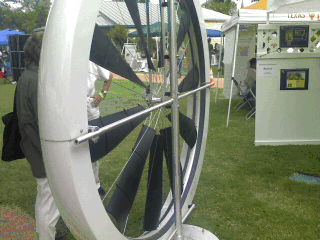


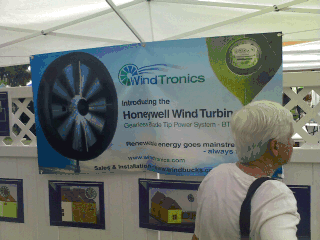
This is a new design in wind energy that uses 3 vertical blade to turn a base generator. It's a very elegant design and should win some award. But the price tag was very high which makes me question the return on investment. This is offered by Aquilo Power. You might ask for current pricing to see if they're more affordable.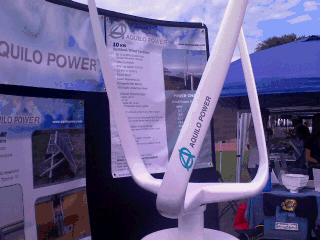
ELECTRIC CARS
More electric cars are coming. A full-range electric car has an electric engine powered by batteries which are charged either by plugging in the car at night or by a small gasoline engine. Unlike a hybrid, the gasoline engine never turns the drive train but simply charges batteries.
Many of you have heard of the Chevy Volt which will be here in 2010.
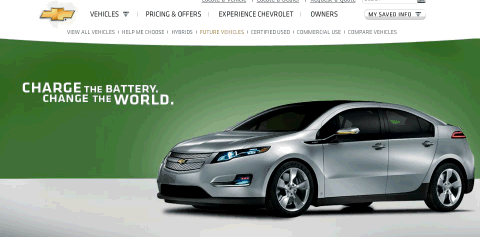
What is news is the new Nissan Leaf. It should be priced more competitively than Volt which will make it more accepted in the market place.
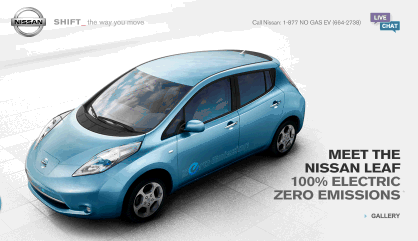
One of best things Toyota did was price Prius under $25,000 so people could afford them. They produced them in large enough numbers to allow market saturation. I hope Nissan and GM do the same thing with these new cars.
Toyota just announced that there will be a plug-in Prius in 2010 which will extend their lead in hybrid production.
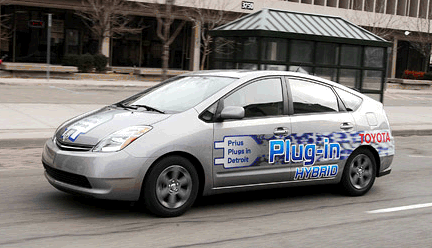
Wednesday, August 12, 2009
Bob McCranie to teach session at Renewal Energy Roundup 2009

I'm very happy to announce that I have been selected to teach a session at this year's Renewable Energy Roundup in Fredericksburg, TX this September. If things go as scheduled, my session will be on Saturday, Sept 26th at 5 pm.
GREEN Realtors® - Environmental Real Estate Options for Existing Homes
Building a green home is a dream of every environmentalist. But most of us live in existing homes that need improving. Over the last 6 years my partner and I have improved our home in Carrollton, TX adding a variety of green features to the property. By doing so, we have shaved 10,000 kwh off our annual electric usage, added 1200 gallons of rain water retention to property and recently installed solar water heating. We have had some experiments that haven’t worked and educated our city inspectors along the way. This presentation will share our successes and our failures in an interactive discussion.
Bob McCranie is a real estate broker in the Dallas area. He is one of the first 100 agents in Texas and one of the first 1,000 in the nation to earn the new GREEN Realtor Designation. As frequent participants at the Renewal Energy Roundup, Bob and his partner, Warren Sippel, have integrated green principles into our home, our businesses, and our family & friend’s homes and businesses. Bob McCranie has been a real estate agent since 2003 and have earned his Brokers license, and the GRI and CRS designations.
Sunday, August 9, 2009
First Solar Tower in United States Powers Up
Read Original Article

Gina Ferazzi / Los Angeles Times
Idealab’s Bill Gross is reflected in a solar tracking mirror on the firm’s rooftop in Pasadena. His ESolar opens an innovative energy facility today in Lancaster.
Entrepreneur Bill Gross' Pasadena firm has had its ups and downs. But it is energized since turning to clean tech, including ESolar, which is opening an innovative solar power facility in Lancaster.
By Alana Semuels
August 5, 2009
The hundreds of glass mirrors break the dusty field in Lancaster, a sea of silver in a landscape of brown.
When switched on for the first time today at an opening gala with investors, local politicians and others, they'll make up the first operational solar tower energy facility in the United States.
They reflect the sun into a tower in the middle of the field, boiling water into steam that travels through pipes to power a turbine and create electricity. The plant, created by Pasadena company ESolar Inc., will be able to power 4,000 homes.
The strength of the small field of mirrors is surprising, but what might be more surprising is the technology's source. It was established by Pasadena incubator Idealab, a 1996 creation of entrepreneur Bill Gross. Gross, whom Time magazine once called the "man with a billion dollar brain," generated some big hits with GoTo.com, Internet Brands Inc. and Cooking.com, along with such misses as Eve.com and EToys.
Idealab, which has counted director Steven Spielberg and actor Michael Douglas among its backers, has been spreading its reach to the green technology sector.
In the last three years, it has created RayTracker Inc., a solar tracking solution for photovoltaic systems; Distributed World Power, which designs solar systems for developing countries; Aptera Motors, which designs fuel-efficient cars; and ESolar.
It is jumping into the environmental market as venture capital is flowing more into clean-tech companies. Investment in such firms shot up 73% in the second quarter from the previous quarter, according to Ernst & Young, and is expected to continue growing.
The percentage of clean-tech investments to total investor funding has increased to double digits over the last three years, said Doug Regnier, an Ernst & Young partner leading its Pacific Southwest clean-tech consulting business.
Energy "is probably the biggest opportunity of the century," Gross said. "The world's energy needs and the demand to make that clean energy is going to be a challenge and an opportunity for smart entrepreneurs."
Though focused on computer software for two decades, Gross said he returned to his passion for solar energy in 2000 as power shortages loomed. The Caltech graduate bought the restaurant next door to Idealab and turned it into a machine shop, eventually running solar experiments on the roof. Idealab's first clean-tech firm, Energy Innovations, was created in 2001 to convert solar applications for commercial use. Idealab hired 50 people in the next three years to work on such ideas as a fuel-saving car and a portable solar device for developing countries.
The concept for ESolar came about as Idealab engineers started thinking about ways to provide cost-efficient solar energy for utilities and realized that most solar panels in commercial use were too big to be cost-efficient.
"We tried to figure out the angle we could exploit where we can zig where other people zag," Gross said.
They came up with what Gross calls an unorthodox plan: "Go small." Rather than make giant solar panels, they sized them at one square meter. That made the panels easier to install, putting them together like Legos rather than erecting a giant solar facility.
The smaller mirrors also are able to be aimed more quickly at the boiler target, said Michael Liebelson, head of the low-carbon development group at NRG Energy Inc., which is building plants using ESolar technology. Idealab's software expertise helped it devise a way to manipulate the mirrors for better precision, he said.
"ESolar has one of the most, if not the most, innovative solar thermal technologies out there," Liebelson said.
The ESolar plant in Lancaster went up on the barren desert site in 18 months, said Lancaster Mayor R. Rex Parris. He's trying to make his city a center for alternative energy. "For an alternative energy to go on the line in 18 months, it's literally unheard of," he said.
ESolar has lined up more than $130 million in investments from such firms as NRG, ACME Group, Google's philanthropic arm and Oak Investment Partners.
For Gross, ESolar's effort is a sign that the interest in solar is growing -- and that Idealab still has its knack for building companies and persuading venture capitalists to invest, even in a tough economy.
And it helps Gross regain a foothold after mutual fund giant T. Rowe Price and others sued him in 2002, alleging self-dealing and fraud, and shareholders bailed him out in 2006 after he failed to repay a $50-million personal loan.
"The biggest factor is when you've demonstrated that you can take a company from revenue to profit to successful exit," he said. "That makes an investor comfortable that you can do it again."
Friday, July 31, 2009
How we put together our Rain Water system
• Two 330 gallon tanks which were once used for Hawaiian Punch drink juice concentrate.
• Three standard 55 gallon rain barrels.
• Six additional 55 gallon barrels converted to hold water, like these pictured here.

We added guttering to our roof line, put the barrels in the right locations and did a rain dance.
Two of our Five downspouts drain directly into the 330 gallon tanks. The three remaining downspouts drain into the 3 standard rain barrels, and then we ran hoses from the three standard rain barrels to the 6 additional barrels to add capacity and run off.
Monday, July 20, 2009
AC solar panels: One step closer to DIY solar? - from
by Martin LaMonica
Start-up GreenRay Solar has raised money to finalize development of a solar panel that puts out household-grade alternating current, a technology that backers say will make solar power more accessible to homeowners.
The Westford, Mass.-based company said that it has raised $2 million from the Quercus Trust and 21Ventures, which will allow it to start production of its solar panels in the fourth quarter this year. Since its founding three years ago, the company had raised $3.5 million in state and federal clean-energy grants.

GreenRay's AC Solar Module will turn out electricity that meshes with household alternating current and voltage. Solar panels put out direct current, and then an inverter, typically placed in a home's basement or outside the house, converts the direct current to alternating current.
Instead of a large inverter for many panels, there are a number of companies developing microinverters that do the DC-to-AC conversion right on the panel.
This design simplifies installation and offers a number of other benefits, said GreenRay CEO Miles Russell. Cutting out the single inverter is safer because installers are dealing with lower voltages.
Microinverters also make an array deliver more reliable performance, say advocates. When one direct current panel is shaded, that drops the performance of all the panels connected to it. Also, it's easier to gather data on an array's performance, Russell said. GreenRay's panels will transmit performance data over the wires and transmit it to the Web via a gateway, he said.
Does this mean that installing solar panels is a do-it-yourself job? Russell said that very handy people could install GreenRay's 200-watt panel, but they are electrical appliances so require typical safety precautions and inspection.
"The do-it-yourself moniker is more of a long-term objective. You could imagine them at a Home Depot and they could be installed for an extra fee," he said.
Another advantage of AC solar panels is that a person could install only a few, rather than a full array, without the cost of an inverter. On the other hand, microinverters do add cost to a solar panel, which is one reason that microinverters have not been commercialized in the past.
Martin LaMonica is a senior writer for CNET's Green Tech blog. He started at CNET News in 2002, covering IT and Web development. Before that, he was executive editor at IT publication InfoWorld.
Wednesday, June 24, 2009
Microsoft wants to show you how to cut your utility bills.
From CNET.com
Microsoft wants to show you how to cut your utility bills.
The software giant will enter the burgeoning business of home-energy management on Wednesday with Hohm, a free Web application designed to show consumers how to conserve electricity and natural gas. Microsoft's chief research and strategy officer, Craig Mundie, is scheduled to introduce Hohm and discuss Microsoft's energy strategy at the Edison Electric Institute utility industry conference on Wednesday.
It's a move that stands to shake up home-energy monitoring, a business that dozens of start-ups and IT industry heavyweights, including Google, Cisco, and Verizon, are moving into. There are already several advice Web sites that help consumers get tips on how to save money by providing guidance on weatherizing a home, for example.
But Microsoft designed Hohm as a cloud-computing application--built on the Azure online operating system and Bing search engine--so that users can tap into back-end data analytics for more tailored advice. Hohm provides tips based on models licensed from the Department of Energy and Lawrence Berkeley National Laboratory, which were developed with years of data, according to Microsoft.

The Hohm residential energy management application gives consumers ways to track energy use at home and offers advice on cutting bills.
(Credit: Microsoft)
Another break from the rest of the pack is that Microsoft on Wednesday plans to make a software development kit available to utilities, which would allow a customer's bill information to be fed automatically into the application. Initially, most users need to input data manually, but over time, the company expects that many utilities will provide that service.
"It's analogous to financial applications when they were released years ago that interacted with banks' online applications," said Troy Batterberry, product unit manager for Hohm. "Now you'd be hard-pressed to find a bank that doesn't export data to Quicken or another common format. We see energy going the same route," said Batterberry.
The recommendations from Hohm should get better over time as more people use it, which will improve the underlying analytics, he said.
The first utilities to sign on to use Hohm are Puget Sound Energy, Sacramento Municipal Utility District, Seattle City Light, and Xcel Energy. Two smart-meter vendors--Itron and Landis+Gyr--are also partnering with Microsoft to provide more detailed information.
Business model of the future?
Microsoft has been developing a business around residential energy management for about two years and has been working on the Hohm application for about a year, Batterberry said. He anticipates that it will be in beta testing for about nine months.
Initially, the company plans to sell contextual ads to make some revenue. Down the road, however, Microsoft anticipates that it can become a sort of information broker between customers and utilities looking for ways to improve the efficiency of their customers.
Many utilities have energy-efficiency programs that offer customers discounts to upgrade home equipment, such as more efficient hot water heaters.
As part of their smart-grid programs, some utilities are also testing what are called demand-response programs where they can, with a customer's permission, temporarily turn down an air conditioner thermostat or turn off a hot water heater. This allows the utility to dial back the demand for energy during peak times in exchange for a credit of some sort to consumers.
In a few years, Microsoft expects to be able to aggregate information from several households willing to participate in efficiency programs to utilities. For example, this "demand-side management" service would tell utilities that they can expect a reduction of electricity use during peak times, explained Batterberry.
Personal information is secured by the same service used with Microsoft's HealthVault health care service. But Batterberry said that not everybody will want to cede control of its major appliances.
"Letting customers shed load is an interesting way to keep them in control of their energy usage, but there will be a significant class of consumer that will have issues with centralized control," he said.
Bringing scale home
In the near term, Microsoft expects it can help consumers even if they just want a better dashboard to view home energy usage.
Microsoft and other home energy monitoring companies plan to work with device manufacturers to get energy information from thermostats and "smart plugs." That would allow a person to attach a smart plug to a refrigerator or dishwasher to get usage information in real time to a home network or Web application. Over time, those appliances could be controlled to dial down usage during peak times.
Microsoft also hopes to have more vendors of smart meters, which have two-way communications built in, to support Hohm's data formats, Batterberry said.
Although there is plenty of available information for how to save energy at home, products that provide consumers more detailed usage information or automate tasks are relatively new. The business models to take advantage of efficiency programs in many cases are still under development as well. For example, a utility may prefer that consumers run dishwashers at off-peak times but people are more likely to do that if they can take advantage of cheaper electricity rates.
Microsoft, like Google and many other vendors, are betting that consumers will take a more active role in conserving energy at home. Tools like Hohm will allow them to have better information and take advantage of energy-efficiency programs already offered by utilities, Batterberry said.
"Customers are motivated to save money but one of the problems with this industry is just a lack of awareness," he said.
___
Martin LaMonica is a senior writer for CNET's Green Tech blog. He started at CNET News in 2002, covering IT and Web development. Before that, he was executive editor at IT publication InfoWorld. E-mail Martin.
Tuesday, June 16, 2009
High-altitude wind machines could power NYC
(WIRED) -- The wind blowing through the streets of Manhattan couldn't power the city, but wind machines placed thousands of feet above the city theoretically could.
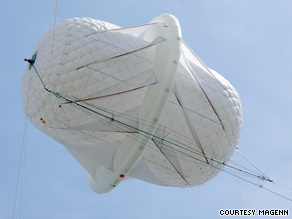
The first rigorous, worldwide study of high-altitude wind power estimates that there is enough wind energy at altitudes of about 1,600 to 40,000 feet to meet global electricity demand a hundred times over.
The very best ground-based wind sites have a wind-power density of less than 1 kilowatt per square meter of area swept. Up near the jet stream above New York, the wind power density can reach 16 kilowatts per square meter. The air up there is a vast potential reservoir of energy, if its intermittency can be overcome.
Even better, the best high-altitude wind-power resources match up with highly populated areas including North America's Eastern Seaboard and China's coastline.
"The resource is really, really phenomenal," said Christine Archer of Cal State University-Chico, who co-authored a paper on the work published in the open-access journal Energies."There is a lot of energy up there, but it's not as steady as we thought. It's not going to be the silver bullet that will solve all of our energy problems, but it will have a role."
For centuries, we've been using high-density fossil fuels, but peaking oil supplies and climate concerns have given new life to green technologies. Unfortunately, renewable energy is generally diffuse, meaning you need to cover a lot of area to get the energy you want. So engineers look for renewable resources that are as dense as possible. On that score, high-altitude wind looks very promising.
Wind's power -- energy which can be used to do work like spinning magnets to generate electricity -- varies with the cube of its speed. So, a small increase in wind speed can lead to a big increase in the amount of mechanical energy you can harvest. High-altitude wind blows fast, is spread nicely across the globe, and is easier to predict than terrestrial wind.
These properties have led inventors and scientists to cast their hopes upward, where strong winds have long been known to blow, as Etzler's dreamy quote shows. During the energy shocks of the 1970s, when new energy ideas of all kinds were bursting forth, engineers and schemers patented several designs for harnessing wind thousands of feet in the air.
The two main design frameworks they came up with are still with us today. The first is essentially a power plant in the sky, generating electricity aloft and sending it down to Earth via a conductive tether. The second is more like a kite, transmitting mechanical energy to the ground, where generators turn it into electricity. Theoretically, both approaches could work, but nothing approaching a rigorous evaluation of the technologies has been conducted.
The Department of Energy had a very small high-altitude wind program, which produced some of the first good data about the qualities of the wind up there, but it got axed as energy prices dropped in the 1980s and Reagan-era DOE officials directed funds elsewhere.
The program hasn't been restarted, despite growing attention to renewables, but that's not because it's considered a bad idea. Rather, it is seen as just a little too far out on the horizon.
"We're very much aimed these days at things that we can fairly quickly commercialize, like in the next 10 years or so," said National Renewable Energy Laboratory spokesperson George Douglas.
Startups like KiteGen, Sky Windpower, Magenn, and Makani (Google's secretive fundee) have come into the space over the last several years, and they seem to be working on much shorter timelines.
"We are not that far from working prototypes," Archer said, though she noted that the companies are all incredibly secretive about the data from their testing.
Magenn CFO Barry Monette said he expects "first revenue" next year when they sell "two to four" working prototypes of their blimpy machine, which will operate at much lower altitudes.
"We do think that we're going to be first [to market], unless something happens," Monette said.
In the long term, trying to power entire cities with machines like this would be difficult, largely because even in the best locations, the wind will fail at least 5 percent of the time.
"This means that you either need backup power, massive amounts of energy storage, or a continental- or even global-scale electricity grid to assure power availability," said co-author Ken Caldeira, an ecologist at Stanford University. "So, while high-altitude wind may ultimately prove to be a major energy source, it requires substantial infrastructure."
Saturday, June 6, 2009
DFW HOMES UNDERVALUED
DALLAS (Dallas Morning News) – Home prices in the Dallas area are almost 32 percent undervalued, according to an IHS Global Insight study.
The same study indicates that prices in DFW have remained virtually unchanged over the year ending with first quarter 2009.
Texas housing has traditionally been considered undervalued because of the ease of building in the state, said Jeannine Cataldi, senior economist with Global Insight.
Prices declined in 199 of the 300 markets surveyed.
Sunday, May 17, 2009
May Real Estate & Green Newsletter!!
REAL ESTATE UPDATE:
Well, let’s talk about Real Estate first. The Spring has picked up nicely. The market is not recovered from the last few years of trouble but buyers are able to get mortgages at good rates and sellers with homes in good condition are able to attract lookers. Both sides need to be patient right now as underwriters are reviewing everything and there’s no way to hurry their process. Also, remember that buyers are looking for homes that are move-in ready. I can help you get to that point. I see so many houses were the owners either aren’t trying or can’t afford to make the necessary changes. Those are not the homes that attract buyers.
As a safely issue, if you have a home built in the 70’s or early 80’s go find your Electric Panel and check to see if it has the words “Federal Pacific” on the outside or the word STAB-LOC on the inside. Do this right now and then come back and read the rest. Okay. These boxes are a known fire hazard and I always recommend that a buyer have the seller change them before buying the house. But if you own a home now, you need to get a new panel box asap. The first sign you have of trouble is a house fire. Please don’t ignore this. It’s very important. If you need help, I can come by and help you identify your panel.
GREEN UPDATE:
The Solar Water Heater gets installed either this week or next depending on weather. There are credits from Oncor and from the US Government for green improvements to your home and with those incentives the water heater is a great long term investment. We have 4 vendors give us bids. We’re getting two flat-panel solar collectors and an 80 gallon tank. There will be an electric element just in case we got a week without sun but we’re betting that won’t happen much.
The water tanks are full and we have some new barrels to install and expand our retention. We currently have 810 of water stored but we have 300 more gallons of new tanks we need to hook up.
As far as electrical usage, the dryer hasn’t been used significantly in two months. I’ve been putting the laundry on the line and we’ve learned a lot. We’ve had to stop using Cheer & Tide because they make the fabric wrinkle more because they leave a residue in the cloth. Cloth pins break but can be fixed. And nothing smells better than clothes dried on a line.
Warren’s Garden is producing like crazy. We have carrots and onions coming in. Both are very sweet. We’ll probably drop some of the onions in pickle juice and let them soak awhile. The strawberries have stopped producing but the tomatoes are climbing up the cages. If we have a temperate summer like we seem to be, the tomatoes should be producing for awhile. Up at Warren’s Farm in Denton he has potatoes coming in. The squash and cucumbers are growing too. His onions got rained out. (see pictures below).
Hope all is well with each of you. Let me know if there’s anything I can do to help you or those you know either in Real Estate or Green changes in your life. I’m always available to help. Have a great and safe MEMORIAL DAY!
Wednesday, May 6, 2009
Large ice shelf expected to break from Antarctica
(CNN) -- A large ice shelf is "imminently" close to breaking away from part of the Antarctic Peninsula, scientists said Friday.
Scientists are investigating whether the ice breakup is caused by global climate change.
Satellite images released by the European Space Agency on Friday show new cracks in the Wilkins Ice Shelf where it connects to Charcot Island, a piece of land considered part of the peninsula.
The cracks are quickly expanding, the ESA said.
Scientists are investigating the causes for the breakups and whether it is linked to global climate change.
The Wilkins Ice Shelf -- a large mass of floating ice -- would still be connected to Latady Island, which is also part of the peninsula, and Alexander Island, which is not, said professor David Vaughan, a glaciologist at the British Antarctic Survey.
The ice shelf experienced a great amount of changes last year, the ESA said.
In February 2008, the shelf dropped 164 square miles (425 square kilometers) of ice. In May it lost a 62-square-mile chunk.
Don't Miss
Witnessing climate change
Snow maps from space aid reindeer herders
In Depth: Planet in Peril
That meant the "bridge" of ice connecting Wilkins to the islands was just 984 yards wide at its narrowest location, the ESA said.
Further rifts developed in October and November, said Angelika Humbert of the Institute of Geophysics at Germany's Muenster University.
"During the last year the ice shelf has lost about 1800 square kilometers (694 square miles), or about 14 percent of its size," Humbert said.
Antarctica's ice sheet was formed over thousands of years by accumulated and compacted snow. Along the coast, the ice gradually floats on the sea, forming massive ledges known as ice shelves, the ESA says.
Several of these ice shelves, including seven in the past 20 years, have retreated and disintegrated.
The Wilkins Ice Shelf had been stable for most of the past century before it began retreating in the 1990s.
"It had been there almost unchanged since the first expeditions which mapped it back in the 1930s, so it had a very long period of real stability, and it's only in the last decade that it's started to retreat," Vaughan said.
Wilkins is the size of the state of Connecticut, or about half the area of Scotland. It is the largest ice shelf on the Antarctic Peninsula yet to be threatened.
If the ice shelf breaks away from the peninsula, it will not cause a rise in sea level because it is already floating, scientists say. Some plants and animals may have to adapt to the collapse.
The Antarctic Peninsula is the piece of the continent that stretches toward South America.
Friday, April 24, 2009
Oprah & The Great Pacific Garbage Patch
http://www.oprah.com/article/oprahshow/20090422-tows-ocean-pollution

Currently, scientists believe the world's largest garbage dump isn't on land…it's in the Pacific Ocean. The Great Pacific Garbage Patch stretches from the coast of California to Japan, and it's estimated to be twice the size of Texas. "This is the most shocking thing I have seen," Oprah says.
In some places, the floating debris—estimated to be about 90 percent plastic—goes 90 feet deep. Elsewhere, there are six times more pieces of plastic than plankton, the main food source for many sea animals.
Where did this trash come from? Marine biologists estimate that about 80 percent of the litter is from land, either dumped directly into waterways or blown into rivers and streams from states as far away as Iowa.

Many of those affected by the enormous garbage swirl—like sea birds, turtles and beluga whales—can't speak for themselves. "They get caught in these nets, or they swallow some of these bottle caps," Fabien says. "Killer whales, which are kind of our mirror, our canary in the coal mine, so to speak, are ingesting all sorts of things that are affecting their health."
Experts say plastic trash has already killed millions of sea birds and marine mammals. In one case, pieces of plastic and a cigarette lighter were found in the stomach of a dead albatross.
Beluga whales are also suffering. Fabien says some of these marine mammals have been diagnosed with breast cancer, which may be caused by the chemicals they're ingesting.

"The pesticides that you spray on your dandelions run off into the oceans and end up in the food chain, which ends up back in our plates," he says. "It's a closed system. Everything's connected. We're all connected with the planet in very fundamental ways."
Fabien says the Pacific Ocean garbage swirl isn't unique. In fact, every ocean and many major rivers have them. "This one happens to be the largest one," he says.

If not for yourself, do it for your children. "You wouldn't let a child open up a cabinet under the sink and start tasting the chemicals down there," Fabien says. "So why would you dump those chemicals down the drain and have them end up on your plate, which you then feed to your child?"
To start making a difference, Fabien suggests signing yourself and your children up for local ecological programs. Want to do more? Find more earth-friendly resources!
Tuesday, April 14, 2009
CFLs even more like incandescents
CFLs even more like incandescents
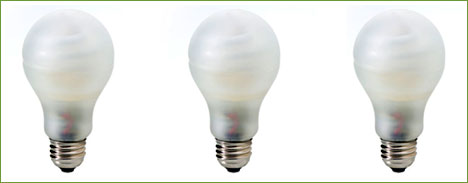
By Philip Proefrock
Posted Mon Apr 13, 2009 10:09am PDT
"I don't like the twisty shape of compact fluorescent bulbs; that's why I don't use them." We've come across this excuse as one of the reasons people don't use CFLs.
GE now has an answer for that. The new GE Energy Smart CFL places a much smaller electronics package inside the neck of the bulb, and puts the familiar twisted fluorescent tubes underneath a cover, so that the entire bulb has the same size and shape as a conventional incandescent bulb.
The new bulbs started to arrive in some stores around the beginning of this year, but will start to be more broadly available (including being in the inventory of some big box chains) around Earth Day later this month (April 22). In addition to the 15-watt bulb, the line will eventually include 9-watt and 20-watt versions to be available by the middle of the year.
So, if there's a fixture where the the bulb is visible and you can't stand the idea of a visible CFL spiral, or if you have that beloved lamp with the shade that clamps directly onto the bulb, now you can fit it with a more responsible and energy-saving bulb that offers the appearance of an incandescent profile.
via Sustainable Home
Saturday, March 21, 2009
New Honda Takes on the Prius

http://www.nytimes.com/2009/03/21/business/21hybrid.html?_r=1&partner=rss&emc=rss
TOKYO — The road is about to get a little more crowded for the Toyota Prius. Starting Tuesday, the Honda Motor Company will offer American consumers what it bills as “the world’s first affordable hybrid.”
Costing just shy of $20,000, the Honda Insight promises to let drivers respond to both of the leading crises of our day: the environment and the recession.
If the Insight’s introduction in Japan is any indication, Toyota should be worried. The car went on sale here on Feb. 6, and orders have soared, reaching 18,000 in just the first three weeks — topping Prius’s current sales. In fact, the Insight pushed Prius out of the top-10-selling cars for February.
“I have people asking about hybrids that I never had before,” said Tsuguhito Tokita, a Honda dealer in Tokyo. “With this price, it’s easy to recommend to anyone.”
If Honda makes inroads in the United States, the world’s largest market for hybrids, it could force the market leader, the Toyota Motor Corporation, to bring down its prices. Japanese news media have reported that Toyota, which controls 70 percent of the American hybrid market, will introduce a cheaper hybrid model with a smaller engine in 2011 — in part, reportedly, because of the Insight’s success.
Sales of hybrids have been hit hard by the global economic crisis. After several years of strong growth in Prius sales, Toyota had virtually no increase in 2008 from the previous year, as the overall auto market struggled.
“In the short term, it’s a very difficult sell,” said Christopher Richter, a Tokyo-based auto analyst at CLSA. “We’ve entered into a very deep recession, and consumers aren’t keen on buying new cars. Fuel prices have plunged, with fuel so cheap people don’t care much about it.”
But so far the Insight has been a bright spot for Honda in an otherwise dismal year of plunging sales that have led the automaker to make painful cutbacks and give up its prized Formula One racing team.
Toyota plans to lower the sticker price of the Prius, according to Japan’s largest business daily, Nikkei. The automaker has refused to confirm the report.
“But I can tell you we’re not satisfied with the current state,” said Paul Nolasco, a Tokyo spokesman for Toyota, which has sold one million Prius vehicles since their introduction a decade ago. “The Insight’s popularity is evidence that the public is recognizing hybrid technology.”
The market for hybrids could be headed for a huge expansion. The development of cheaper technology, economies of scale and more government subsidies for environmentally friendly vehicles could take what was a niche technology into the mainstream.
A bigger market for hybrids could also ensure that they stay the green vehicle of choice over full electric or hydrogen cars, which remain prohibitively expensive. A report released by J. P. Morgan in October predicted that the global market for hybrids “will rise exponentially” to 9.6 million in 2018 from 500,000 units in 2007— and the current economic slump will not significantly slow that rise, the authors said.
The Insight could bring about a big turnaround for Honda, which tried selling hybrids for a decade without much success. In fact, it discontinued a previous Insight model in 2006, believing consumers found hybrids too expensive. But when sales of Toyota’s Prius rose as oil prices spiked, Honda quickly changed course.
Behind the less expensive Insight is an aggressive cost-cutting effort, as well as technological sacrifices.
Instead of the more complicated hybrid system used in the Prius, the Insight’s main source of power is a lightweight gasoline engine that is assisted by smaller batteries. That greatly reduces manufacturing costs, but gives the Insight lower fuel efficiency than the Prius — 43 miles per gallon on the highway compared with 45 miles per gallon for the Prius. The Insight also shares parts with other Honda models, which helps the carmaker keep costs to a minimum.
Honda has also struck a chord with an overhaul of the car’s shape. One reason its previous hybrids failed to take off, analysts say, was that they did not come in distinctive shapes.
“A lot of people who drive hybrids want to make the statement, ‘I am driving a hybrid,’ “ Mr. Richter said.
But Honda’s new Insight looks remarkably like — well, Toyota’s triangular Prius, which has become synonymous with hybrid technology. Analysts say that should help sales.
The global economic slowdown could be an advantage for the Insight, at least over the Prius.
“Several years ago, the Prius would have won hands down,” Mr. Richter said. “But when you’ve got a raging recession, you come down to the question: Do you want the fancier car with greater fuel economy, or the one that still has pretty good economy, allows you to be seen driving hybrid, and is cheaper?”
“The Insight could steal a lot of Toyota’s thunder,” he said.
Whatever the outcome of the new hybrid race, it is certain to reinforce the dominance of Japanese automakers in eco-friendly cars. Unlike their American counterparts, Japanese automakers have long made energy efficiency a priority, teaming up with Japan’s electronics conglomerates to develop high-powered batteries.
In 1996, Toyota and Matsushita, now Panasonic, formed a joint venture to produce nickel-metal hydride batteries for hybrid cars. It plans to produce a million batteries a year by 2010. The venture also plans to make more powerful lithium-ion batteries.
Honda, which gets its batteries from Panasonic and Sanyo, has also invested heavily in battery production, setting up a company with a battery maker, GS Yuasa, to produce lithium-ion batteries. That move came partly because Honda was nervous about obtaining batteries from the same company as its archrival, Toyota. The greater capacity would allow Honda to introduce hybrid versions of its other models.
A string of auto companies worldwide, from Ford to start-ups like Tesla Motors, have announced or introduced hybrids, plug-ins or electric cars. Others are hurrying research into fuel cells and other alternatives. A technological breakthrough could still turn the market on its head, analysts say.
But for now, only Toyota and Honda have invested the money to mass-produce the mainstay batteries at a scale that makes economic sense. Batteries are still expensive to develop and produce, and kinks in the technology remain, as demonstrated by a string of flare-ups involving Sony-made lithium-ion laptop batteries three years ago.
“Other companies just don’t have a mass-production setup yet,” said Kohei Takahashi, a Tokyo-based auto analyst for J. P. Morgan. “They might be able to come up with hybrids, but they’re too expensive.”
Thursday, March 19, 2009
Planet Green - Message from a friend
Take Advantage of the Government's Weatherization Assistance Program
If life gives you a recession, make recession-ade.
By Josh Peterson, Los Angeles, CA, USA | Thu Mar 19 09:00:00 EDT 2009

man with insulation photo
Stockbyte/Getty
READ MORE ABOUT:
Green Home | Green Home Renovation | Heating | Insulation | Smart Bargains
Proper weatherization can reduce your heating bills by 32%. That's over $300 dollars a year. Not bad. Of course, you may not be able to afford such niceties. The United States Government has a program that helps low-income families obtain weatherization for their homes. That's good news, since we're living in such trying times right now. You can use that extra money to put food on the table.
A well-insulated house won't just save you money, it will also benefits the environment. The less energy expended to heat your home, the less pollution emitted. Everyone wins.
First, you need to find out of your are eligible Seniors, families with a disabled member and families with children are given preference in this program. The government provides this state-by-state guide (PDF). Look it over and see if you are eligible.
Each state runs it's own program. You will have to find the office in your state. Go into the office. Fill out a form answer some questions and if you are eligible, they will send experts to make your home energy efficient.
For more information, check out the EERE's Weatherization Assistance Program Page.
Do you have strong opinions about new green initiatives? Have your say with our View and Vote - Obama Green Stimulus Projects.
Sunday, March 15, 2009
Could the Volt Jump-Start GM?
Automaker Hopes Battery-Powered Car Will Be A Game Changer. Critics Say It's Too Expensive.
By Kendra Marr
Washington Post Staff Writer
Saturday, March 14, 2009; D01

General Motors frequently holds up the Chevrolet Volt as a symbol of its future and a testimony to its ingenuity when it asks Washington officials for billions of dollars in federal aid.
So prominent a role has the battery-powered car played in discussions that when members of President Obama's auto task force flew to Detroit earlier this week for a series of meetings, they decided to take it for a spin.
Their impression, according to an administration official: The Volt certainly shows promise, but it is no panacea for what ails GM in the near term.
The problem is GM will likely have to price the vehicle far higher than a comparable family car with a gas-powered engine, putting it out of reach for many consumers, particularly if oil prices remain low.
Further, the rollout comes as rivals roll out partial-electric hybrids at a fraction of the cost.
With the ability to drive 40 miles on a single charge, the Volt aims to usher in a new era of gasoline-free daily commutes when the car debuts in late 2010 in the Washington area and San Francisco, GM officials say. But some analysts and government officials predict the car may be initially priced up to $40,000, and possibly more, because of its costly lithium-ion batteries.
"Over time the costs will come down and be competitive with conventional cars," said Bob Lutz, GM vice chairman for global product development, who has taken on the Volt as his last project before retirement. "Although right now that's not the case."
Meanwhile, hybrid fuel-efficient cars are getting cheaper as the competition for alternative-fuel vehicles heats up. Honda's Insight LX, a traditional gas-electric hybrid that goes on sale this month, will start at $19,800. Chinese battery manufacturer BYD sells a plug-in for $22,000 and plans to enter the U.S. market in 2011.
Toyota plans to start testing a plug-in, lithium-ion version of its Prius at the end of this year. Chrysler has created several plug-in electric prototypes. And Ford has announced plans to build a family of electrified vehicles by 2012.
"Consumers are going to have a great choice," said Jim Lentz, Toyota's top U.S. executive. "That's what makes it a horse race."
The Volt was supposed to be a game changer for GM. With it, the beleaguered automaker burdened with the perception that its products are out-of-touch hopes to leapfrog more cautious rivals.
Lutz makes no apologies for GM's strategy, even though he admits that putting the Volt's battery technology into GM's upscale Cadillac line might have made the initial pricing more palatable. After all, affluent customers might be willing to brave the inevitable first-generation glitches, since this would likely be their second or third car.
"Doing it in a Cadillac would have made it financially easier to do, but on the other hand we wanted something that's boldly applicable," he said. "Our big 5-million-unit global path is Chevrolet. With the Volt we can sell it around the world."
California automakers Tesla Motors and Fisker Automotive are speeding exactly in the opposite direction. Both sell electric sports coupes priced above $88,000 -- targeting well-off, environmentally minded buyers such as former Secretary of State Colin Powell and Black Eyed Peas frontman will.i.am. In a few years, the two carmakers hope to come out with a mass-market version.
Fisker chief executive Henrik Fisker likens his business model to the one for flat-screen televisions. At first they were expensive, $20,000 status symbols, but in a few years companies were able to perfect the technology and sell in large enough quantities so that the average family could pick one up at Best Buy for under $1,000.
"The quicker you get started in the luxury market, the quicker you can get to the down market," Fisker said.
For now, the small volumes of cars being produced means that there are few suppliers, and little competition to drive down prices.
"We didn't start with a Honda Civic because it would be a $70,000 to $80,000 Honda Civic," said Elon Musk, chief executive and one of the founders of Tesla.
Still, the Volt has inspired a legion of fans -- the so-called "Volt Nation." Lyle Dennis, creator a popular Volt news Web site, stirred up such a demand for the car that GM invited him to Detroit to talk to top executives half a dozen times.
"Electric cars are not necessarily new," said Dennis, a New Jersey neurosurgeon. "But the idea that a major automaker is going to produce them on a mass scale, now that's something new. This could really make a difference."
GM doesn't have a Volt waitlist, so Dennis created his own. To date, about 47,000 people are "registered" on his Web site to buy the Volt, from all 50 states and 85 countries. And Volt fans say they are willing to pay an average of $31,297.89 for the car.
In a way, this is a shot at redemption. A decade ago GM discontinued its first electric car, called the EV-1, and terminated all leases. The outrage that followed was a public relations nightmare and the subject of a scathing documentary, "Who Killed the Electric Car?"
As GM's financial woes grow, the Volt has become a source of company pride.
At GM's first press event at the annual Detroit auto show, out marched Michigan Gov. Jennifer Granholm (D) with the Volt silently gliding in front of her, past the cheering masses and bobbling signs reading "We're Electric" and "Here to Stay."
A few days later, on the same stage, GM chief executive G. Richard Wagoner Jr. declared that the company would be assembling the Volt's battery packs at a new plant in Michigan -- a victory for Granholm's relentless push to plug her flagging state into new alternative energies. The $30 million plant holds the promise of bringing new high-tech, "green" jobs to a state that has the highest unemployment in the nation.
Staff writers David Cho and Steven Mufson contributed to this report.
Friday, March 13, 2009
Wind farm to be built off Delaware shore - CNN.com
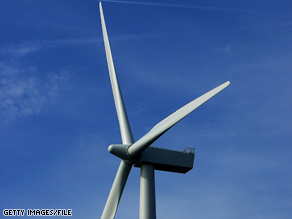
(CNN) -- A contract to build what is being called the nation's first offshore field of wind turbines was announced Monday by a Delaware utility and a firm that will build the generators off the Atlantic coast.
The 150 wind turbines off Delaware are expected to be operational in four years, say developers.
The 150 wind turbines off Delaware are expected to be operational in four years, say developers.
Officials from Delmarva Power and Bluewater Wind announced details of their agreement in Newark, Delaware.
Bluewater spokesman Jim Lanard said the power company will get about 16 percent of its electricity from a field of 150 wind turbines, anchored in the seafloor about a dozen miles off Rehoboth Beach, Delaware.
The contract with Delmarva would use less than half the projected generating capacity the energy park is expected to have when completed. The rest would be sold to other customers.
The project's cost is estimated at $1.6 billion, according to a project official with Bluewater.
The offshore site is expected to be operational within four years, but the timing depends on how quickly regulatory agencies can review and approve the construction project.
Don't Miss
* In Depth: Solutions
Using electricity generated by the wind, "Delmarva Power will be able to light about 50,000 homes a year, every year" for the duration of the 25-year contract, Lanard said, with first power expected by 2012.
He said the project may help stabilize consumer energy costs, since the contract locks in the price Delmarva will pay per kilowatt-hour.
Bluewater has previously established an offshore "energy park" operating off Denmark.
Each turbine in the Delaware project is to sit on a pole about 250 feet above the waterline, where the ocean is about 75 feet deep. The poles are to extend 90 feet into the seafloor, and the units are to be constructed to withstand hurricane-force winds.
From the shore, the park will be visible only on clear winter days, and the turbines will be nearly invisible during summer months when Rehoboth Beach fills with vacationers, Lanard said.
Each blade on the three-blade rotor is to be 150 feet long.
"If they can see them at all, the turbine blades would cover about the size of your thumbnail, and the poles would be about the width of a toothpick," he said.
Wednesday, March 11, 2009
Incentives on Solar Water Heating
ONCOR ADDS INCENTIVE PROGRAM
DALLAS (Oncor) – Monday, Oncor expanded its solar energy initiatives to include the Take A Load Off, Texas Solar Water Heating Incentive Program.
Oncor’s Solar Water Heating Incentive Program offers cash incentives for the purchase and installation of qualifying residential solar water heating systems. Oncor expects to install about 1,100 new solar systems over the next four years through this $2 million program. Only homes served by Oncor and using electric water heating systems are eligible.
By preheating water with the sun’s energy, systems typically reduce the electricity required for hot water needs by 40 to 85 percent. Oncor will pay an incentive of $600 to $1,500 per installed system, based on the system’s predicted performance.
As a result of its 31 programs that encourage energy efficiency, Oncor will operate one of the largest energy efficiency initiatives sponsored by a regulated utility in Texas.
For more information on the Solar Water Heating Incentive Program and other Oncor energy efficiency programs, visit http://www.oncor.com/electricity/teem/default.aspx.
Tuesday, March 10, 2009
TODAY: Maytag recalling 1.6 million refrigerators
About 1.6 million refrigerators are being recalled by Maytag Corp. due to an electrical failure in the relay - the component that turns on the refrigerator's compressor - that can cause overheating and pose a serious fire hazard.
http://today.msnbc.msn.com/id/29611744/from/ET/
Tuesday, March 3, 2009
GREEN Presentation Tomorrow - March 4th - WCR Dallas!
Wednesday, March 4 2009 - 11:30am - 1:00pm-----------Dallas Athletic Club - 4111 LaPrada in Mesquite
Presenter: Bob McCranie Let's All do our Share to Go Green!*Tips on small steps to take* What can we do in our own homes
NAR Launches 'Green Designation" Realtors! Did you know that National Association of Realtors has launched a green designation? THis is a perfect opportunity to get a head start on what issues are at hand and how we can do our part to help. Many consumers are asking questions and now, you will be the expert. Call or log on to NAR for more details.
Sunday, January 11, 2009
Whole lot of new Hybrid Cars about to be Announced
When reading these reports be sure to notice the EXPECTED NUMBER TO BE PRODUCED. Ford and General Motors love to talk about hybrids, electrics and fuel cell cars but they produce such a limited number of them that it creates no impact on the market.
http://www.ecogeek.org/content/view/2456/69/
Thursday, January 8, 2009
Bob's January 2009 newsletter... Optimists vs Pessimists - Homestead - Time to Vote!
My father-in-law was a long-time member of the Optimists Club in his small Ohio town. And I always wondered if there was another club across town for the Pessimists and if they ever rumbled. Two opposite powers marking turf and keeping each other in check. Very West Side Story. That’s how the news feels these days. There are a lot of things to be down about and a few signs of light at the start of the tunnel.
OPTIMISTS
Interest rates are trending in the 5’s and 6’s and there’s a stir of people looking to sell and buy property. The phone has started ringing and the email box has interested folks trickling in. So there’s the optimism. Good interest rates for those who qualify and some people venturing out into the market. Let’s hope they don’t see their shadow. If you have patience and a good product priced right, people will come.
PESSIMISTS
As for the pessimism, we only have to look at the jobless numbers, the industry bailouts, and the rest of the news reports on CNN or FOX. What’s next? I wish I could tell you. But what does seem clear is that it will take at least 12 to 18 months to start to see changes, which means we have to be smarter and work harder to sell homes.
BEING SMARTER & WORKING HARDER
To reach out to more buyers and to put my listing out in front of people, I’ve launched several websites and pages aimed at different cities in the metroplex and different price ranges in each. See www.BobMcCranie.com
Plus, I’ve created a MOBILE website for cell phone users who want to search the MLS while out driving the neighborhood. Its m.BobMcCranie.com From here you can use your web-enabled mobile phone to check properties as you drive by. It’s just starting out but we’re adding flyers for listings and email & text messaging options to instantly request showings or contact lenders.
I also started sites aimed at golf communities as well. www.DallasGolfCommunities.com, www.FriscoGolfCommunities.com and I’m working on Carrollton, Plano, and 8 other cities of the metroplex.
As always, houses that sell fastest and for the most money are neat, updated and priced right. Buyers can qualify if credit is good and income is stable and provable. There’s still a glut of bank owned and short-sale homes on the market that are driving prices down and we all feel for the families trying to outlast those situations.
REMEMBER to HOMESTEAD!! If you purchased a home in 2008 NOW is the time to file Homestead on the property. Contact me and I’ll show you how! You usually have until April but don’t wait! And DON’T PAY A SERVICE TO DO IT. IT’S FREE!!
TIME TO VOTE: It’s time to vote again in the annual Best of Dallas survey for the Dallas Voice. I’d be thrilled to have your vote for Best Real Estate Agent if you would do me the honor. The link is http://www.dfwreadersvoice.com/2009/Services/default.html and you can also vote for other businesses and providers that you feel deserve the honor.
Let me hear from you. If there’s anything I can do for you, your family or friends I’d be more than happy to help.
Bob McCranie
Broker Associate, GRI, CRS
William Davis Realty
Bob@BobMcCranie.com